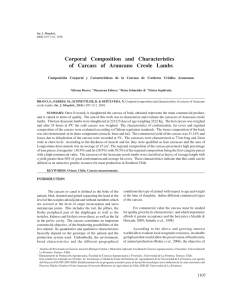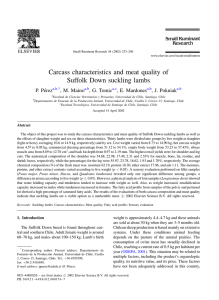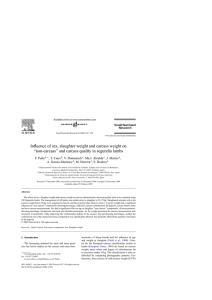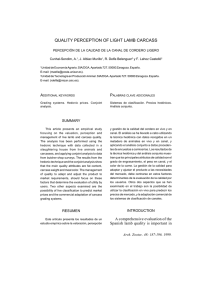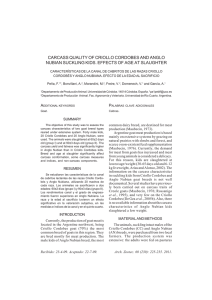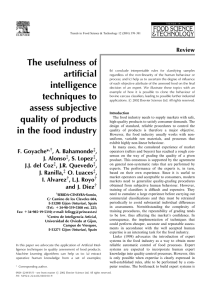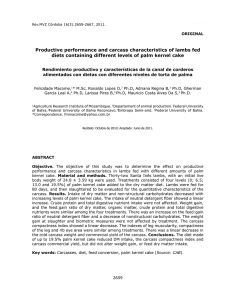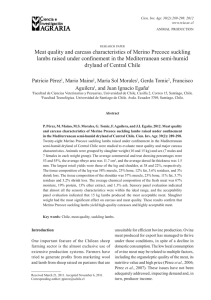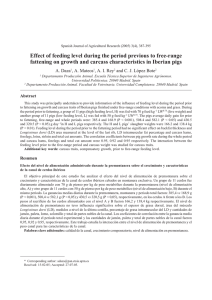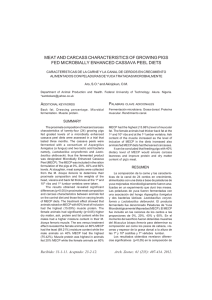Relationship Between Live Animal Weight, Warm and Cold Carcass
Anuncio
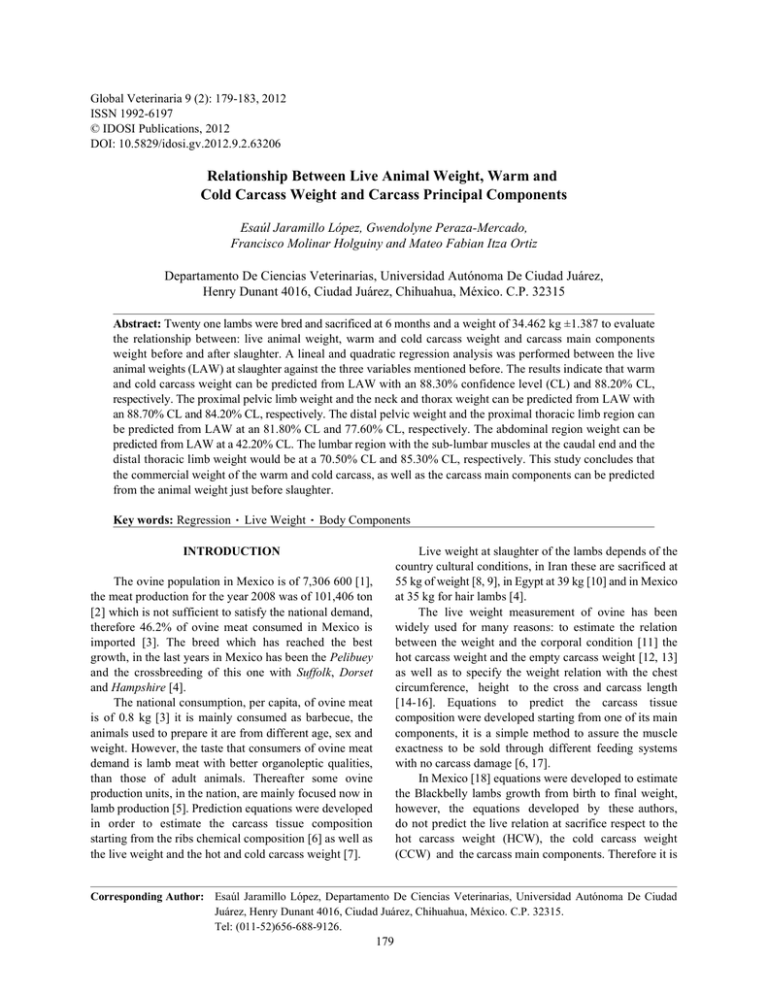
Global Veterinaria 9 (2): 179-183, 2012 ISSN 1992-6197 © IDOSI Publications, 2012 DOI: 10.5829/idosi.gv.2012.9.2.63206 Relationship Between Live Animal Weight, Warm and Cold Carcass Weight and Carcass Principal Components Esaúl Jaramillo López, Gwendolyne Peraza-Mercado, Francisco Molinar Holguiny and Mateo Fabian Itza Ortiz Departamento De Ciencias Veterinarias, Universidad Autónoma De Ciudad Juárez, Henry Dunant 4016, Ciudad Juárez, Chihuahua, México. C.P. 32315 Abstract: Twenty one lambs were bred and sacrificed at 6 months and a weight of 34.462 kg ±1.387 to evaluate the relationship between: live animal weight, warm and cold carcass weight and carcass main components weight before and after slaughter. A lineal and quadratic regression analysis was performed between the live animal weights (LAW) at slaughter against the three variables mentioned before. The results indicate that warm and cold carcass weight can be predicted from LAW with an 88.30% confidence level (CL) and 88.20% CL, respectively. The proximal pelvic limb weight and the neck and thorax weight can be predicted from LAW with an 88.70% CL and 84.20% CL, respectively. The distal pelvic weight and the proximal thoracic limb region can be predicted from LAW at an 81.80% CL and 77.60% CL, respectively. The abdominal region weight can be predicted from LAW at a 42.20% CL. The lumbar region with the sub-lumbar muscles at the caudal end and the distal thoracic limb weight would be at a 70.50% CL and 85.30% CL, respectively. This study concludes that the commercial weight of the warm and cold carcass, as well as the carcass main components can be predicted from the animal weight just before slaughter. Key words: Regression Live Weight Body Components INTRODUCTION Live weight at slaughter of the lambs depends of the country cultural conditions, in Iran these are sacrificed at 55 kg of weight [8, 9], in Egypt at 39 kg [10] and in Mexico at 35 kg for hair lambs [4]. The live weight measurement of ovine has been widely used for many reasons: to estimate the relation between the weight and the corporal condition [11] the hot carcass weight and the empty carcass weight [12, 13] as well as to specify the weight relation with the chest circumference, height to the cross and carcass length [14-16]. Equations to predict the carcass tissue composition were developed starting from one of its main components, it is a simple method to assure the muscle exactness to be sold through different feeding systems with no carcass damage [6, 17]. In Mexico [18] equations were developed to estimate the Blackbelly lambs growth from birth to final weight, however, the equations developed by these authors, do not predict the live relation at sacrifice respect to the hot carcass weight (HCW), the cold carcass weight (CCW) and the carcass main components. Therefore it is The ovine population in Mexico is of 7,306 600 [1], the meat production for the year 2008 was of 101,406 ton [2] which is not sufficient to satisfy the national demand, therefore 46.2% of ovine meat consumed in Mexico is imported [3]. The breed which has reached the best growth, in the last years in Mexico has been the Pelibuey and the crossbreeding of this one with Suffolk, Dorset and Hampshire [4]. The national consumption, per capita, of ovine meat is of 0.8 kg [3] it is mainly consumed as barbecue, the animals used to prepare it are from different age, sex and weight. However, the taste that consumers of ovine meat demand is lamb meat with better organoleptic qualities, than those of adult animals. Thereafter some ovine production units, in the nation, are mainly focused now in lamb production [5]. Prediction equations were developed in order to estimate the carcass tissue composition starting from the ribs chemical composition [6] as well as the live weight and the hot and cold carcass weight [7]. Corresponding Author: Esaúl Jaramillo López, Departamento De Ciencias Veterinarias, Universidad Autónoma De Ciudad Juárez, Henry Dunant 4016, Ciudad Juárez, Chihuahua, México. C.P. 32315. Tel: (011-52)656-688-9126. 179 Global Veterinaria, 9 (2): 179-183, 2012 necessary to develop these equations in order to be applied by producers or technicians to estimate, indirectly, the carcass yield and its main components. So the objective of the present research is to develop prediction equations to relate the live weight at sacrifice respect of the hot carcass weight, the cold carcass weight and the carcass main components such as rear lower legs, rear upper legs, lower back, abdomen, ribs, shoulder and front leg. MATERIALS AND METHODS This work was carried out on September 2005 at the Veterinary Science Department of the Autonomous University of Ciudad Juarez, Chihuahua, Mexico, located at 31°44'36" north latitude and 106°25'54" west longitude and 1,127 m over sea level height [19] with an annual precipitation of 230mm and an annual media temperature of 16.5°C and a thermal oscillation of 14.5°C [20]. Twenty-one lambs were utilized, ten Pelibuey and eleven Polipay x Rambouillet of approximately six months of age with an average weight of 34.461±1.387. Before the slaughter the lambs were subject to a twelve hour empty stomach, afterward they were weighed to determine the live weight at slaughter (LWS). After slaughter the head, skin, limbs, viscera, testicles, as well as lungs and trachea were separated to obtain the hot carcass weight (HCW). The carcass was stored in refrigerator for 24 hours at 4 °C, then after it was weighed to obtain the cold carcass weight. The commercial yield was calculated by means of the following equation: (CCW/LWS)*100. The cold carcass was also divided into two halves, one half was used to obtain the main components (rear lower limb, rear upper limb, lower back, abdomen, ribs, shoulder and front leg) according to the described method by Fisher and de Boer [21] (Figure 1). A correlation matrix was developed (Pearson) between the different variables according to the method described by Steel and Torrie [22] using the Statistic Package SPSS version 15 [23]. A lineal regression analysis was developed according to the following models: y 0+b1x+ and y b0+b1x+b2x2+ . The live weight at slaughter was the independent variable, the hot carcass weight, the cold carcass weight and the carcass main components were the dependent variables, using the described method by Steel and Torrie [22] to predict the live weight relation at slaughter (LWS) with the other variables, using the Statistic Package SPSS version 15 [23]. Fig 1: Carcass main components [21]. A = rear lower limb, B = rear upper limb, C = lower back, D = abdomen, E = ribs, F = shoulder and G = front leg RESULTS AND DISCUSSIONS On Table 1, the matrix correlation is presented and the significance levels between HCW, CCW and the main components of the twenty-one lambs evaluated. The average values as well as the standard error for each one of the evaluated variables is presented in Table 2. LWS of the lambs were 34.462 ±1.387 kg, this weight was similar to that of the lambs used by Bores et al. [4] whom sacrificed the lambs at a weight of 35 kg, but at a different age, as they were sacrificed according to weight. However, [24] sacrificed Pelibuey lambs at a weight of 45.9 kg at 7 months of age. The commercial yield obtained in this research was 48.53%, which differ to the one reported by Partida de la Peña et al. [24] with 50.70%, the differences could be due to the divergences between the weights at slaughter (34.6 vs 45.9). The commercial yield is similar to the one obtained by Partida de la Peña et al. [4] 47%. The commercial yield for Pelagonia lambs sacrificed at 60% from adult weight was of 50.4% [25] and the carcass dressing percentage in the Angora male kids were 45.2 [26]. The carcass main components vary according to the slaughter weight [27] Pelibuey x Dorper lambs which weighed 23.75 kg at slaughter reported a weight of: 1.73 kg 180 Global Veterinaria, 9 (2): 179-183, 2012 Table 1: Correlation matrix between LWS, HCW, CCW and carcass main components LWS LWS 1 HCW 0.94** HCW 1 CCW CCW 0.94** 1** 1 Rear upper leg Rear upper limb 0.93** 0.97** 0.97** 1 Ribs Ribs 0.92** 0.98** 0.98** 0.95** 1 Rear lower leg Rear lower limb 0.88** 0.92** 0.92** 0.92** 0.87** 1 Shoulder Shoulder 0.86** 0.95** 0.95** 0.93** 0.89** 0.89** 1 Abdomen Abdomen 0.65** 0.65** 0.65** 0.515* 0.62** 0.58** 0.534* 1 Lower back 0.84** 0.90** 0.90** 0.86** 0.87** 0.71** 0.88** 0.56** 1 Front leg Front leg 0.92** 0.90** 0.90** 0.92** 0.87** 0.92** 0.82** 0.548* 0.75** 1 Lower back *Significance correlation (P<0.05); ** Highly significance correlation (P<0.01) Table 2: Weight (kg) for each evaluated variable and commercial yield (%) Variable Media Standard Error LWS 34.462 1.387 HCW 16.727 0.648 CCW 16.665 0.645 Commercial yield 48.621% Rear upper leg 4.418 0.180 Ribs 5.885 0.241 Rear lower leg 0.778 0.029 Shoulder 2.517 0.096 Abdomen 1.256 0.057 Lower back 1.159 0.059 Front leg 0.538 0.021 LWS= live weight at slaughter, HCW= hot carcass weight, CCW= cold carcass weight Table 3: The prediction equations, determination coefficient and significance levels of LWS with HCW, CCW and carcass main components Prediction equation Determination R2 Significance y =b0+b1x1+ y =b0+b1x1+b2x12+ y =1.608+0.438(PVS) y =1.545+0.438(PVS) 0.883 0.882 ** y =2.667-0.0198(PVS)+0.00198(PVS) 2 y =0.385+0.159(PVS) 0.887 ** 0.842 ** y =0.788-0.0195(PVS)+0.0005(PVS) 2 y =2.203-0.0416(PVS)+0.0014(PVS) 2 0.818 ** 0.776 ** 0.422 ** LB y =0.333+0.026(PVS) y =-0.086+0.036(PVS) 0.705 ** Front leg y =0.049+0.0142(PVS) 0.853 ** HCW CCW RUL Ribs RLL Shoulder Abdomen ** LWS= live weight at slaughter, HCW= hot carcass weight, CCW= cold carcass weight, RUL= rear upper leg, RLL= rear lower leg, LB= lower back, ** Highly significant (P<0.01) of leg, 0.44 kg of lower back and 1.17 kg of shoulder. Pelibuey lambs which weighed 41.50 kg at slaughter reported a weight of: 5.04 kg of leg, 2.76 kg of lower back and 3.36 kg of shoulder [28]. In this study the weight was: 4.42 kg of leg, 1.16 kg of lower back and 2.52 kg of shoulder, values coincide that was reported by Orozco et al. [28]. The prediction equation and determination coefficients for hot carcass, cold carcass and carcass main components are presented in Table 3. LWS is positively correlated with HCW, CCW and the carcass main components, the lineal equation is better for predicting the relation among LWS with HCW, CCW, ribs, abdomen, lower back and front leg. And the 181 Global Veterinaria, 9 (2): 179-183, 2012 quadratic equation is better for predicting LWS with rear upper leg, rear lower leg and shoulder. The highest determination coefficients were for HCW, CCW, rear upper leg, front leg, ribs and the lowest for abdomen. HCW can be estimated from the LWS since the lineal model explains that 88.30% of the HCW depends on LWS and for CCW this model explains 88.20%. The lowest value was for abdomen in which LWS only determines 42.20%. According to the relation between the LWS and CCW of Karayaca lambs [7] that obtained a determination coefficient of 0.954, which differs to the one of the present study of 0.882, this difference could be due to age of the lambs, since they used animals of 8 to 18 months of age [7]. LWS presented a high relation with the carcass main components, therefore it can be used to estimate them. 6. 7. 8. 9. CONCLUSIONS From live weight of slaughter of lambs HCW, CCW and the carcass main components (rear upper leg, ribs, rear lower leg, shoulder, abdomen, lower back and front leg) can be estimated without having to sacrifice the animals. 10. REFERENCES 1. 2. 3. 4. 5. 11. INEGI. Censo Agropecuario, 2007. VIII Censo Agrícola, Ganadero y Forestal. www.inegi.gob.mx. Consulta: 29 jul. 2010. SIAP., 2011.gob.mx: http:// www.siap.gob.mx/ artus/ eis/ loadgstage.asp. Consulta 1/06/2011. SAGARPA. ,2005. Secretaría de Agricultura Ganadería, Desarrollo Rural, Pesca y Alimentación. Estimación del consumo nacional aparente de carne de ovino 1990-2005 [en línea] www.sagarpa.gob.mx/ Dgg/CNAovi.htm. Consulta: 29 jul. 2010. Bores, Q.R.F., M.P.A. Velazquez and A.M. Hereida, 2002. Evaluación de razas terminales en esquemas de cruza comercial con ovejas de pelo F1. Técnica Pecuaria en México, 40: 71-79. De Lucas, T.J., Q.L.A. Zarco, P.E. González, P.J. Tórtora and P.C. Vásquez, 2002. Evaluación biológica de dos sistemas de apareamiento en ovinos de raza Columbia en producción intensiva. Veterinaria México, 40: 105-122. 12. 13. 14. 15. 182 Fernandes, M.H.M.R., K.T. Resende, L.O. Tedeschi, Jr. J.S. Fernandes, I.A.M.A. Teixeira, G.E. Carstens and T.T. Berchielli, 2008. Predicting the chemical composition of the body and the carcass of ¾ Boer x ¼ Saanen kids using body components. Small Ruminant Res., 72: 90-98. Cam, M.A., M. Olfaz and E. Soydan, 2010. Body Measurements Reflect Body Weights and Carcass Yields in Karayaka Sheep. Asian Journal of Animal Veterinary Advances, 3: 120-127. Hasheim, M., F. Zamani, M. Vatankhah and S. Hossein Zadeh, 2012. Effect of Sodium Bicarbonate and Magnesium Oxide on Performance and Carcass Characteristics of Lori-Bakhtiari Ram Lambs. Global Veterinaria, 8: 89-92. Reisi, K., F. Zamani, M. Vatankhah and Y. Rahimiyan, 2011. Effect of Raw and Soaked Bitter Vetch (Vicia ervilia) Seeds As Replacement Protein Source of Cotton Seed Meal on Performance and Carcass Characteristics of Lori-Bakhtiari Fattening Ram Lambs. Global Veterinary, 7: 405-410. Abdel-Magid, S.S., H.H. Abd El-Rahman, M.I. Mohamed and I.M. Awadalla, 2008. Utilization of Chick Pea Straw and Pea Straw in Feeding Growing Rahmani Lambs. American-Eurasian Journal of Agricultural and Environmental Sci., 4: 214-217. Sanson, D.W., T.R. West, W.R. Tatman, M.L. Riley and M.B. Judkins, 1993. Relationship of body composition of mature ewes with condition score and body weight. Journal of Animal Sci., 71: 1112-1116. Atti, N. and M. Ben Hamouda, 2004. Relationships among carcass composition and tail measurements in fat-tailed Barbarine sheep. Small Ruminant Res., 53: 151-155. Shiriyan, S., F. Zamani., M. Vatankhah and E. Rahimi, 2011. Efect of Urea Treated Wheat Straw in a Pelleted Total Mixed Ration on Performance and Carcass Characteristics of Lori-Bakhtiari Ram Lambs. Global Veterinary, 7: 456-459. Janssens, S., D. Winady, A. Tylleman, C.H. Delmotte, W. Van Moeseke and W. Vandepitte, 2002. The linear scheme for sheep in Belgium: breed averages and assessor quality. Small Ruminant Res., 51: 85-95. Riva, J., R. Rizzi, S. Marelli and L.G. Cavalchini, 2004. Body Measurements in Bergamasca Sheep. Small Ruminant Res., 55: 221-227. Global Veterinaria, 9 (2): 179-183, 2012 16. Atta, M. and O.A. El Khidir, 2006. Use of heart girth, wither height and scapuloischial length for prediction of live weight of Nilotic sheep. Small Ruminant Res., 55: 233-237. 17. Carrasco, S., G. Ripoll, B. Panea, J. Alvarez-Rodríguez and M. Joy, 2009. Carcass tissue composition in light lambs: Influence of feeding system and prediction equations. Livestock Sci., 126: 112-121. 18. Gonzalez, G.R., H.G. Torres and A.A.M. Castillo, 2002. Crecimiento de corderos Blackbelly entre el nacimiento y el peso final en el trópico húmedo de México. Veterinaria México, 33: 443-453. 19. Esquivel, C.V.H., 2010. Resumen Mensual en la Estación Meteorológica de Ingeniería de la Universidad Autónoma de Ciudad Juárez. http://148.210.20.37:1279/clima/Estación01/NOAA MO.TXT. Consulta: 5 De Agosto De 2010. 20. Álvarez, G.A., 1980. Boletín meteorológico del estado de Chihuahua. Dirección de Geografía y Meteorología, S.A.R.H. Gobierno Del Estado De Chihuahua. 21. Fisher, A.V. and H. De Boer, 1994. The EAAP standard method of sheep carcass assessment. Carcass measurements and dissection procedure. Report of the EAAP Working Group on Carcass Evaluation in cooperation with the Instituto Agrónomico Mediterraneo de Zaragoza and the Directorate General for Agriculture in Brussels. Livestock Production Sci., 38: 149-159. 22. Steel, R.G.D. and J.H. Torrie, 1980. Principles and procedures of statistics. A biometrical approach. 2nd ed. Kogakusha, LTD. Tokyo, Japan: McGraw-Hill Book Co. 23. George, D. and P. Mallery, 2006. SPSS for Windows Step by Step. A simple Guide and Reference, 6 th ed. Boston, MA. USA: Ed. Pearson. 24. Partida De La Peña, J.A., V.D. Braña and R.L. Martínez, 2009. Desempeño productivo y propiedades de la canal en ovinos Pelibuey sus cruzas con Suffolk o Dorset. Técnica Pecuaria en México, 47: 313-322. 25. Christodoulou, V., V.A. Bampidis, E. Sossidou and J. Ambrosiadis, 2007. Evaluation of Florina (Pelagonia) sheep breed for growth and carcass traits. Small Ruminant Res., 70: 239-247. 26. Abbasi, R.E., F. Abdollahzadeh, S. Salehi and R. Abdulkarimi, 2011. Effect od Dietary Metabilizable Energy and Crude Protein on Feed Intake, Carcass traits and Mohair Production by Markhoz (Iranian Angora) Male Kids. Global Veterinaria, 7: 443-447. 27. Mendoza, V.A.M., S.W. Marshall, I.F. Uña and V.J. Bertot and M.O.R. Vázquez, 2008. Determinación del Rendimiento de la Canal, Regiones y Tejidos por Medidas Zoométricas en Ovinos Dorper x Pelibuey. In the proceeding of the XIV Congreso Nacional de Ovinocultura. Tuxtla Gutiérrez, Chiapas. 28. Orozco, H.P., P.R. Lazcano, T.M.A. García and C.L.M. Hernández, M.R.D. Méndez, G.L. Corona, 2008. Efecto de grano de sorgo ensilado en el comportamiento productivo y características de la canal en corderos. In the proceeding of the XIV Congreso Nacional de Ovinocultura. Tuxtla Gutiérrez, Chiapas. 183
